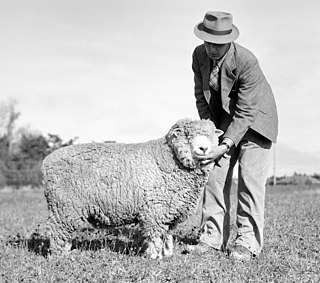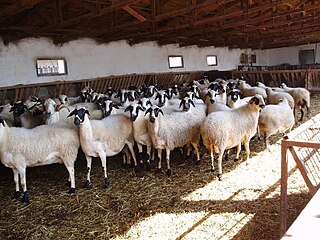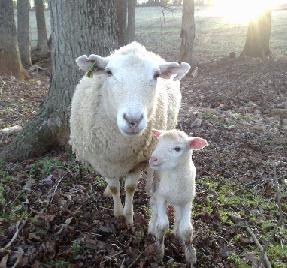The Perendale is a breed of sheep developed in New Zealand by Massey Agricultural College for use in steep hill situations. The breed is named after Sir Geoffrey Peren, and it achieves its aims by being the offspring of Romney ewes and Cheviot rams with sturdy legs. It is raised primarily for meat.

The Border Leicester is a British breed of sheep. It is a polled, long-wool sheep and is considered a dual-purpose breed as it is reared both for meat and for wool. The sheep are large but docile. They have been exported to other sheep-producing regions, including Australia and the United States.

The Jacob is a British breed of domestic sheep. It combines two characteristics unusual in sheep: it is piebald—dark-coloured with areas of white wool—and it is often polycerate or multi-horned. It most commonly has four horns. The origin of the breed is not known; broken-coloured polycerate sheep were present in England by the middle of the seventeenth century, and were widespread a century later. A breed society was formed in 1969, and a flock book was published from 1972.

The Hampshire or Hampshire Down is a breed of sheep which originated around 1829 from a cross of Southdowns with the Old Hampshire breed, the Wiltshire Horn, and the Berkshire Nott, all horned, white-faced sheep — these were native to the open, untilled, hilly stretch of land known as the Hampshire Downs.

The Texel is a breed of domestic sheep originally from the island of Texel in the Netherlands. A heavily muscled sheep, it produces a lean meat carcass and will pass on this quality to crossbred progeny. The wool is around 32 micrometres and is mostly used for hosiery yarns and knitting wools. It is presently a popular lean meat sheep across Europe, as well as Australia, New Zealand and the United States.

Corriedale sheep are a dual purpose breed, meaning they are used both in the production of wool and meat. The Corriedale is the oldest of all the crossbred breeds, a Merino-Lincoln cross developed almost simultaneously in Australia and New Zealand and first brought to the United States in 1914. The Corriedale is internationally farmed, in Australia, New Zealand, the United States of America, Southern Brazil, Uruguay and Patagonia. Corriedales are one of the most popular sheep breeds in Uruguay. On the Falkland Islands, Polwarth and Corriedale form the main sheep breeds.
The Polypay sheep breed is a white, medium-sized, polled sheep which was developed in the 1960s at the U.S. Sheep Experiment Station in Dubois, Idaho. In general, Polypay sheep are noted for being a highly prolific maternal dual-purpose breed. It produces yearly about 4.2 kg of wool and is weaned at 120 days.

The Shetland is a small, wool-producing breed of sheep originating in the Shetland Isles, Scotland but is now also kept in many other parts of the world. It is part of the Northern European short-tailed sheep group, and it is closely related to the extinct Scottish Dunface. Shetlands are classified as a landrace or "unimproved" breed. This breed is kept for its very fine wool, for meat, and for conservation grazing.

The Charollais is a breed of domestic sheep originating in east central France, in the same region in which Charolais cattle originated, Charolles and Saône-et-Loire. It is known for ease of lambing and is used as a terminal sire to increase muscling and growth rate of the lambs. It has been exported internationally, and is commonly used in the United Kingdom as a sire to produce market lambs from pure-bred ewes and mules.

Sheep are quadrupedal, ruminant mammals typically kept as livestock. Like all ruminants, sheep are members of the order Artiodactyla, the even-toed ungulates. Although the name sheep applies to many species in the genus Ovis, in everyday usage it almost always refers to Ovis aries. Numbering a little over one billion, domestic sheep are also the most numerous species of sheep. An adult female is referred to as a ewe, an intact male as a ram, occasionally a tup, a castrated male as a wether, and a young sheep as a lamb.
The South African Meat Merino or SAMM is a wool and meat sheep originating in South Africa, but now found throughout the world.
The Llanwenog is a breed of domestic sheep originating in Wales. It was developed in the 19th century from the Llanllwni, the Shropshire, Welsh Mountain, and Clun Forest breeds. The Llanwenog's native locale is the Teifi Valley, in western Wales, but it has since spread into other areas. The breed association was formed in 1957. Llanwenogs have black faces and medium-length wool. They have a docile temperament and are known for their profligacy in lambing. The breed has a very placid temperament, is easily handled, easily contained and is well suited to stress free inwintering if necessary. This has important consequences for the health of both the animal and its keeper. This breed is raised primarily for meat.

The Zwartbles is a breed of domestic sheep originating in the Friesland region of the north Netherlands. There it was primarily used for the production of sheep milk as well as lamb and mutton. They were often kept alongside dairy cattle herds.
The British Milksheep is a robust, dual-purpose sheep commonly known for its milking characteristics.

The Chios is a breed of domestic sheep with specific unknown origins. It is classified as a semi-fat tailed breed. The Chios are bred mainly for their milk production. Although there is speculation that this breed may have been crossed with Kivircik and Dagliç, it is commonly accepted that it originated on the Greek island of Chios.

The Newfoundland, also called the Newfoundland Local, is a breed of sheep native to Newfoundland.
The Rideau Arcott is a breed of domestic sheep native to Canada, one of only a few livestock breeds native to the country.

Australian White is a large, white breed of Australian meat sheep which was originally developed for Australian conditions. The Australian White sheep are a stabilised composite haired meat breed comprising White Dorper, Van Rooy, Poll Dorset and Texel genetics.

The Polled Dorset is an American breed of domestic sheep. It is a polled (hornless) variant of the British Dorset Horn. It was developed at the North Carolina State University Small Ruminant Unit in the 1950s after a genetic mutation led to the birth of a polled ram. After some years of breeding work, a true-breeding polled strain was established.
The Small-tailed Han is a breed of sheep native to the Shandong Province of China. It is known for its very high rates of reproduction and extremely high fecundity. Its high rates of reproduction have made it a growing part of China's livestock sector.













